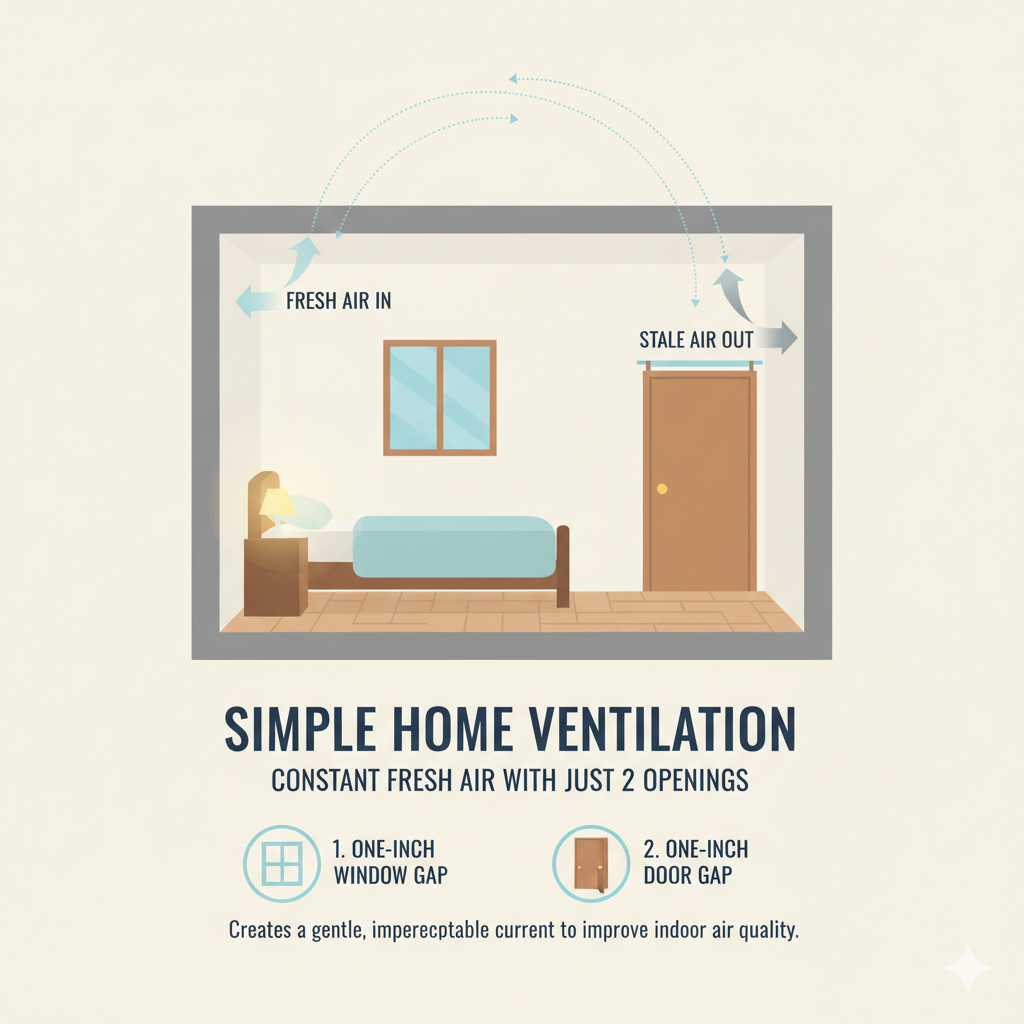Abuses of the Lungs: How Poor Ventilation Damages Lung Health and Overall Well-Being
Do you ever finish a long day in a stuffy office or wake up from a full night’s sleep still feeling drained? The culprit might not be your workload or your mattress—it could be the very air you’re breathing. The critical connection between lung health and ventilation has become a silent casualty of modern comfort. Understanding the effects of poor ventilation and reclaiming the profound fresh air benefits our ancestors knew is a powerful step toward restoring your energy, clarity, and vitality.
Why Modern Homes Are Undermining Lung Health and Ventilation
Our ancestors thrived on cold, well-ventilated chambers. They designed their homes with broad-mouthed chimneys, uncorked doors, and open windows that secured a constant flow of cool, pure air. Daily exercise through family work for women and children, combined with outdoor labor for men and boys, secured cheerful spirits and healthful activity favorable to both body and mind.

But as wealth and luxury increased, everything changed. We sealed our houses tight, corked our windows, shut up our fireplaces, and introduced central heating and air conditioning systems. Think about it: we seal ourselves in climate-controlled offices, commute in recirculated car air, and relax in airtight apartments. From morning to night, we disconnect ourselves from a consistent source of fresh, moving air.
The Effects of Poor Ventilation on Lung Function and Daily Health
Men and women now work in heated offices, stores, and facilities with their brains stimulated and muscles inactive. The stale air from many skins and lungs accumulates as the only fountain of supply to the lungs and the dependent capillaries throughout the body. Then they return home and sleep in close, unventilated, and sometimes overheated rooms.
Even when we travel, especially in winter when cold, pure air would most invigorate us, we pack ourselves into sealed vehicles. Modern heating systems burn oxygen and thin the air, while windows remain fastened and every crack sealed tight. The effects of poor ventilation extend beyond discomfort—they disrupt oxygen exchange, weaken immunity, and impair lung function over time.

The idea that every pair of lungs needs approximately 150 liters of pure air every hour—as much as the stomach needs its daily food—remains unacknowledged by most people when arranging their homes, workplaces, and family spaces. If society understood this subject as it deserves, health officers would inspect every building and hold individuals accountable for creating unhealthful atmospheres that poison themselves and their families. This isn’t dramatic language—it’s a genuine medical concern, not just a comfort issue.
How to Ventilate a Room the Right Way for Healthy Lungs
One significant difficulty stems from the fact that the philosophy of ventilation receives so little practical attention. Not one in a thousand educated persons—not even one in a hundred who have studied physiology and consider pure air important to health—truly understands how to ventilate a room properly. To explore more fresh air benefits and understand the science behind optimal breathing environments, visit our Fresh Air Benefits for Health Guide.
If you've ever felt drowsy in a meeting or woken up with a foggy head, the culprit is likely stagnant air. The right way to ventilate a room acts as a reset button for your environment, flushing out toxins and flooding your cells with the oxygen they crave for energy and repair.
Simple, Effective Steps for Proper Home Ventilation
Achieving perfect airflow doesn’t require fancy equipment or expensive systems. You need to create an “In and Out” circulation system:
The ‘In’ Point: Crack open the top of a window on one side of your room. This allows cooler, fresh air to enter and gently sink into the space.
The ‘Out’ Point: Ensure an opening on the opposite side—a door cracked open or a vent at the top. This allows warm, stale air to escape naturally.
This creates a gentle, cross-cutting current that refreshes the air without creating a drafty, uncomfortable environment. Learning how to ventilate a room properly can significantly reduce the buildup of toxins that compromise respiratory function.
In a common-sized bedroom with two people, an inch opening at the top of a window and an equal opening over the door will ventilate sufficiently. When ventilating, ensure the current isn’t so large or strong that occupants feel it directly, as this causes colds. Establish a gentle, imperceptible current. Where significant air exchange is needed for many people, create several small openings instead of one large opening.

Churches, schools, and social gathering spaces benefit most from furnaces placed underneath, opening at one end of the room, while ventilators at the room’s top should sit at the opposite extremity. This creates a current passing through the entire space. As explained in our Respiratory Physiology Guide, efficient lung function depends on continuous access to clean, oxygen-rich air.
The Forgotten Power of Fresh Air Benefits
A crowd of people in one building spending both day and night always involves gradual constitutional deterioration for all—especially the most susceptible—unless uncommon care provides a proper supply of pure air. All rooms should open into long halls constantly swept by outer air from opposite doors and windows.
A clinical study published on ResearchGate, a platform for scientists and researchers, found a direct correlation between exposure to indoor particulate matter and worsened lung function in asthma and COPD patients, highlighting that our indoor air quality represents a genuine medical concern (ResearchGate study). This demonstrates why understanding lung health and ventilation proves critical for long-term wellness.
Breathing Habits, Clothing, and Their Impact on Lung Health
Many modern boarding schools, dormitories, and institutions demonstrate inadequate ventilation despite teaching physiology for years. School rooms and lodging rooms lack proper ventilation arrangements. Meanwhile, young people experience constant drain on their brain and nervous systems through intellectual activity and moral responsibility. Year after year, fevers and various diseases affect young people, leaving friends wondering why so much sickness occurs in these environments.
Manufacturing facilities and labor shops present similar challenges. Thousands of young people congregate to work in oxygen-depleted air until their constitutions weaken, then return home to remain invalids for life. The effects of poor ventilation in these settings create lasting health consequences.
Adding to the mischief of vitiated air, restrictive clothing practices compound the problem. Many people wear tight garments around the body, preventing the lower lungs—where air cells most abound—from functioning properly. Modern fashion often sacrifices function for style, as detailed in our Clothing and Health Guide.
Abdominal breathing has ceased among a majority of adults. Ribs compressed by tight clothing make even full inspiration at the top of the lungs impossible. This custom has operated from parent to child so extensively that many children are now born with deformed thoraxes that have room only for imperfectly-formed lungs. To understand the advantages of proper breathing techniques, explore our post on Deep Breathing Benefits.
Science-Backed Evidence on Lung Health and Indoor Air
Globally, respiratory decline linked to pollution and poor ventilation continues rising—a trend documented by the National Library of Medicine. The full, round chest of perfect health has become a specimen rarely seen, and it diminishes in frequency every day.
Multiplied distortions caused by long-continued unnatural positions at school or work create round shoulders and bent forms that cramp the lungs in size and action. In many cases, attempts to ventilate rooms by uninformed people create serious problems. Some wait until a room becomes hot with almost poisonous air, then—when everyone’s skin perspires heavily—open a door or window and create a strong, direct draft that causes colds and injurious chills.
Protecting Lung Health Through Awareness and Lifestyle
The only proper and safe method involves arrangements that keep a room perfectly ventilated at all times through processes that create no strong current in any direction. A window open at the top with a thin curtain, on one side of a room, plus another window or door with a moderate opening on the other side, suffices where few people gather. When many people occupy a space, multiply the number of ventilating openings. For comprehensive guidance on natural breathing techniques, visit our guide on Nose Breathing Benefits.
Understanding how to ventilate a room correctly and consistently applying these principles transforms your living and working environments. The fresh air benefits our ancestors enjoyed remain available to us—we simply need to reclaim them through conscious choices and proper ventilation practices.
Conclusion: Let Your Lungs Breathe Free
The relationship between lung health and ventilation defines how effectively our bodies access life-sustaining oxygen. By understanding the effects of poor ventilation and implementing simple solutions, you restore the fresh air benefits that support vibrant health. Your lungs deserve the same priority as your diet and exercise—give them the pure air they need to thrive.
Science-Backed Resources for Healthy Lungs
Lung Function and Indoor Particulate Matter – ResearchGate Study Clinical research demonstrating how indoor air quality directly impacts respiratory function in asthma and COPD patients.
Global Lung Health Overview – National Library of Medicine Comprehensive synopsis examining respiratory health trends and environmental factors affecting populations worldwide.
FAQ Schema
How often should I ventilate my room?
Ideally, rooms should be gently ventilated at all times, not just occasionally. Instead of throwing windows open once or twice a day, create a small, consistent airflow by cracking a window or vent on opposite sides of the room. This ensures a steady exchange of fresh air without causing drafts. Continuous ventilation helps remove indoor pollutants, balance humidity, and maintain oxygen levels—key to promoting long-term lung health and ventilation efficiency.
What are the signs of poor ventilation?
If you often feel tired, lightheaded, or experience headaches in enclosed spaces, you’re likely breathing stale air. Other signs include musty odors, condensation on windows, and a feeling of “stuffy” or heavy air. Poor ventilation allows carbon dioxide and airborne toxins to accumulate, which can lead to weakened immunity, reduced concentration, and respiratory discomfort. These are clear indicators that it’s time to reassess how to ventilate a room effectively.
Can ventilation help with respiratory problems?
Yes — proper ventilation is one of the simplest and most effective ways to protect lung function. According to clinical studies, including research published on ResearchGate, poor indoor air quality directly worsens conditions like asthma and COPD. Allowing clean, oxygen-rich air to circulate helps the lungs filter toxins more efficiently, reducing inflammation and promoting better breathing. Learn more about these fresh air benefits in our Fresh Air Benefits for Health Guide.
